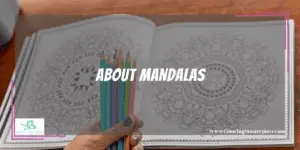Are you one of the millions of people across the world who’ve taken up coloring mandalas as a way to de-stress and let the woes of the day go? Or maybe you just really like to make beautiful art? Want to know how to make your mandalas stand out from the others in the crowd?
About Mandalas

Mandalas are nothing new. They’ve been around for thousands of years and have appeared throughout history within a variety of different cultures. While they do have ties to some religions, that isn’t all they have been associated with.
A mandala is a series of rings that are filled with geometric patterns and shapes. Historically, they have held many various meanings. They were heavily associated with Hinduism and Buddhism as symbols that stood for harmony and the universe with no end. The term “mandala” is a Sanskrit word that means circle.
Today, people all over the world color in mandalas as a form of therapy or relaxation. Studies are showing a link between reactions in the brain and hormones in the body and decreases in anxiety and stress levels.
Yes, it’s a fun pastime, but it can be so much more than just that. The practice of coloring mandalas has been shown to have many health benefits.
7 Fun Tips for Coloring Mandalas
Whether you’ve been doing this for a while and you’re just looking for a way to make your mandalas look different and unique or you’re just starting with adult coloring, these 7 tips will help you enhance the look of your mandalas and make them unique.
1. Choose a Color Scheme—Less Is More
When you sit down to color a mandala, you can just wing it and pick whatever color comes to mind if you want to. And to be honest, there’s nothing wrong with that. That’s one of the beauties of coloring, it’s all about you and you can do it however you want to.
A really fun way to go about creating a beautiful, unique mandala though, is to start by choosing a color scheme that’s made up of fewer colors than your entire collection consists of. You can get some really interesting effects when you limit your colors. You’ll want to familiarize yourself with the color wheel and some of the different color terms before you select the hues you’re going to use. Here’s a brief look at a few of them so you have somewhere to begin:
-
-
-
- Primary colors – Red, blue, and yellow. The colors from which the other colors on the color wheel are made of.
- Secondary colors – Orange, green, and violet. The first set of colors you get just from mixing the primary colors.
- Tertiary colors – These are colors like yellow-green or red-orange that are made when you mix a primary color with a secondary color.
- Analogous colors – You’ll find these colors all right next to each other around the color wheel. A color scheme like this will give your mandala a harmonious feel and flow.
- Complementary colors – These colors are across from each other on the color wheel. Violet is across from yellow for instance.
- Monochromatic – If you want a mandala that is high on the harmony scale, you can go with a monochromatic color scheme. To do this, you just use different shades of the same color.
-
-
These are just a few of the terms you should know when you’re trying to pick a color scheme. There are more, but these will get you started. You can play around with the different color schemes and see what you come up with as a favorite. Another way to add even more fun and uniqueness to your mandala is to alternate color schemes within its sections.
One other way people often choose color schemes is to find inspiration in something around them. Nature is somewhere you can find beautiful color schemes. Let’s say you’re out and about and you encounter a flower basket that catches your eye. Take a picture of it and use the colors in your next mandala. If you’re flipping through a magazine and see something in it that has colors you find attractive, snap a picture of the page or just rip the whole thing out to use for setting up your color palette.
2. Pick a Starting Point—Inside or Outside
There are different thought processes for where you should start when coloring a mandala. Try them all and discover how each different method makes you feel. Here is a look at two of them:
You’ll find a lot of people say you should start from the inside because this is the core, the heart of the mandala. The cool thing about going from the inside out is that the mandala appears to grow as you work your way from the center to the outside edge. The growth of your artwork adds to the feeling of satisfaction and inner peace that you get from coloring in a mandala.
You can also start at the outside edge and work your way in. It will feel different than going from the core out. You can do a ring or two for each coloring session unless you have the time to finish the whole thing in one sitting.
Working your way from the outer edge to the inside is said to have therapeutic benefits because it’s like peeling away one layer at a time. Colorists can think of each section as being representative of something they get hung up thinking about or worrying about. As they complete each sectional ring of the mandala, they can “peel” that thought away and just be present in the moment.
3. Color In Sections
You can choose to start on any section of the mandala and then move to another once you’ve finished it. Typically, there are four to eight sections. Everything is symmetrical.
Coloring the different sections with all kinds of various color combinations will allow you to explore your creativity. You can stick to one color scheme for the entire mandala. Or, you could use a couple of different color schemes throughout the page. Maybe you could even choose a different color scheme for each different section of the mandala to see what you come out with in the end.
Something fun to try is to color the same mandala several times but starting in a different place each time. You could color one from the outside in, one from the inside out, and several that you just start in whichever section you decide to. You can use a different color scheme for each mandala as well. You’ll find that you can make the same mandala look unique each time by switching up your starting spots and color schemes.
4. Play with White
People sometimes forget about white. Colorists will sit down to color in their mandalas thinking they have to fill in each section with a color because that’s what they’re doing—coloring. The thing is though, the absence of color makes colors adjacent to the blank space pop.
Try leaving some white spaces throughout your mandalas and see what kind of effect you get from it. Especially if you want to make another color look more vibrant, leaving white next to the color will make it look brighter.
Along with white, you can also play around with black. Maybe incorporate entire sections that are only white and black. This will add a whole new depth to your mandala. Sometimes it can even make parts of it look almost three-dimensional.
Try playing with white if you’re trying to get a section to pop and you can’t seem to get it to do that. Don’t feel like every space has to be filled with color. The use of white will help you make your mandala look more interesting and unique by helping to accentuate all the colors around it.
5. Experiment with Different Art Media
This is where you can make your mandala look unique. You can add some intricate details by using more than one medium and various art tools. What do we mean by that?
Mandalas can be colored with gel pens, colored pencils, watercolor brush pencils, markers, and even crayons. What’s more, you can use a combination of these media that allows you to incorporate some cool effects into your artwork.
With the right tools, you can blend colors, mix them, layer them, and even make them look like oil paintings. There are lots of other ways to add unique touches to your mandalas too. Some of the techniques you can try include these:
-
-
-
- Mixed media – An example of using mixed media is to color in a section with a colored pencil. Take a gel pen and draw a line at the edge of the section you just colored. Use a paintbrush with a flat end to move the wet gel on top of the colored pencil section.
-
-
-
-
-
- Alternating media – You can color a section with a marker and then one with colored pencils. Experiment with alternating different kinds of art media to see what it does to the mandala’s appearance.
-
-
-
-
-
- Blend your medium – Blending one type of media throughout the whole mandala can give you a pretty dramatic effect. Let’s say you’re using colored pencils that are soft enough for blending and mixing. You can use various tools to do the blending—silicone spatulas, pencil erasers, your finger, cotton swabs, or paint brushes. Different tools can give you different results.
-
-
-
-
-
- Play with textures – You don’t have to use just straight coloring in for a solid block of color. Try different techniques that add texture—stripes, polka dots, swirls, stippling (dots that connect), scribbling, shapes, or cross-hatching (stripes that cross over each other).
-
-
6. Don’t Rush, Pace Yourself
Don’t feel like you have to sit down and color a mandala in one coloring session. There’s no reason for you to rush this process. To make your mandala look unique and stunning, just take your time. Don’t force it, let your creativity just flow onto the page in front of you.
Much of our lives are spent rushing through things so we can keep up with schedules and be ready to move on to the next task. Allow yourself to relax and enjoy the time you’re sitting in front of a mandala working to make it look the way you want it to. This isn’t something that you’re just trying to finish. Remember to slow down and focus on what you’re doing.
What happens when we rush is that the outcome isn’t what we wanted it to be. That can leave you with feelings of dissatisfaction. You’re trying to produce something that makes you feel good when you look at it. It’s unlikely you’re going to do that if you speed through the process. Leave the pressures of time out of this activity and let it be the positive experience it is meant to be. You’ll find that will lead to the results you want.
7. Have Fun and Listen to Your Instincts
The most important factor that will impact the beauty and uniqueness of your mandala is having fun. You have to let yourself enjoy the coloring and the creative journey you’re on. Let your instincts guide you.
Keep in mind that this is your project meant for your pleasure and benefit. Creativity isn’t about a learned skill. It’s about instinct and feeling. That means if you make a mistake, it’s not a mistake. It can’t be because it’s part of your creation. Don’t let a “mistake” bother you. Be creative and carry on.
The point is there’s no way for you to mess a mandala up if you’re simply listening to your instincts and having fun. You are the only you so that alone will make your mandala very unique. The rest of these tips are just about stretching your creativity with inspiration. Follow your instincts and the unique outcome you’re looking for will present itself.
Helpful Guidance

Our goal with this article is to give you tips for coloring mandalas that will enhance them and make them unique. We’re trying to offer helpful guidance here, but the truth of the matter is that coloring mandalas and making them unique is all about you. You get to choose a color scheme. You get to pick a starting point. You get to play with white. You can choose different media and techniques. And you need to slow down and pace yourself. Most of all, you’ve got to have fun and follow your instincts. Do that, and you’ll create incredible mandalas that look just as unique as you are.
Feel like you’re going around in circles with mandalas? Click here to download my free adult coloring eBook and sign up for my email newsletter
Disclaimer: The information provided by ColoringMasterpiece.com (“The Site”) is for general informational purposes only. All information on the Site is provided in good faith, however, we make no representation or warranty of any kind, express or implied, regarding the accuracy, adequacy, validity, reliability, availability, or completeness of any information on the Site. Under no circumstance shall we have any liability to you for any loss or damage of any kind incurred as a result of the use of the Site or Reliance on any information provided on the Site. Your use of the Site and your reliance on any information on the Site is solely at your own risk. This blog post is for educational purposes only and does not constitute legal advice. Please consult a legal expert to address your specific needs.
Terms and Conditions: https://coloringmasterpiece.com/terms-and-conditions/

